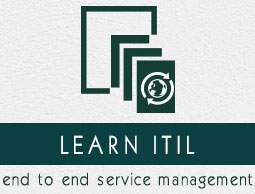
- ITIL - Home
- ITIL - Overview
- ITIL - Terminologies
- ITIL - Service Basics
- ITIL - Service Lifecycle
- Service Strategy
- ITIL - Service Strategy Overview
- ITIL - Service Strategy Roles
- ITIL - Strategy Generation
- ITIL - Service Portfolio Management
- Business Relationship Management
- ITIL - Demand Management
- ITIL - Financial Management
- Service Design
- ITIL - Service Design Overview
- ITIL - Service Catalogue Management
- ITIL - Service Level Management
- ITIL - Capacity Management
- ITIL - Availability Management
- ITIL - Service Continuity Management
- Information Security Management
- ITIL - Supplier Management
- Service Transition
- ITIL - Service Transition Overview
- ITIL - Project Management
- ITIL - Change Management
- Service Assets and Configuration Management
- Release and Deployment Management
- ITIL - Service and Validation Testing
- Service Operation
- ITIL - Service Operation Overview
- ITIL - Event Management
- ITIL - Incident and Request
- ITIL - Problem Management
- ITIL - Access Management
- Continual Service Improvement
- CSI Overview
- Service Reporting
ITIL - Terminologies
Here in this chapeter, we will discuss some basic terminologies of ITIL that will help to understand the tutorial easily and quickly. The following table comprises of all basic terminologies required to learn ITIL −
| Sr.No. | ITIL Terminologies |
|---|---|
| 1 |
ITIL Information Technology Infrastructure Library is a set of best practices being practiced by most of the infrastructure service providers to deliver services to the customers to meet their business needs within predicted cost and quality. |
| 2 |
Service Service is a means of delivering value to customers by achieving customer's desired results while working within given constraints. |
| 3 |
Service Level It is measured and reported achievement against one or more Service Level Targets. |
| 4 |
Service Level Agreement It is agreement between service provider and customer. The SLA describes the IT Service, documents Service Level Targets and specifies the responsibilities of provider and customer. |
| 5 |
Service Strategy Service Strategy helps to design, develop and implement service management as organizational capabilities and strategic assets as well. It enables a service provider to consistently outperform competitive alternatives over time, across business cycles, industry disruptions and changes in leadership. |
| 6 |
Service Model Service Model is the high level description of the service and components required to deliver that service. |
| 7 |
Service Portfolio Service Portfolio is the set of services provided by the service provider. |
| 8 |
Service Catalogue Service Catalogue is the set of specific services being provided by service provider to a specific customer. |
| 9 |
Customer Portfolio
Customer Portfolio is used to record all customers of IT service provider. |
| 10 |
Demand Management Demand Management is very important and critical process in service strategy. It helps to understand customer demand for services so that appropriate capacity can be provisioned to meet those demands. |
| 11 |
Pattern of Business Activity PBA is an extremely important activity achieved by knowing customer how they operate and future requirement they might need. |
| 12 |
Service Design Service Design provides a blueprint for the services. It not only includes designing of new service but also devises changes and improvements to existing ones. |
| 13 |
Operational Level Agreement (OLA) OLA is an agreement between IT service provider and another part of same organization. |
| 14 |
Service Level Report It gives insight into a service providers ability to deliver the agreed service quality. |
| 15 |
Service Level Requirements It is a document containing the requirements for a service from the client viewpoint, defining detailed service level targets. |
| 16 |
Service Asset Service Assets are the resources and capabilities owned by the service provider enabling it to deliver service to the customer. |
| 17 |
Configuration Item (CI) Configuration Item is subset of service assets and have direct impact on delivering services. All servers, networks, applications that have impact on production are known as configuration item |
| 18 |
SACM Service Assets and Configuration Management (SACM) deals with maintaining up-to-date and verified database of all assets and CIs which are also made available to other service management processes. |
| 20 |
Change Change refers to modifying existing services. |
| 21 |
Event Event is defined as detectable occurrence that has significance for the delivery of IT service. Events are created by Configuration Item (CI) or the monitoring tools. |
| 22 |
Incident Incident is defined as any disruption in IT service. Incident can be reported either through the Service Desk or through an interface from event management to incident management tools |
| 23 |
Service Request Service Request refers to demand by the users. These requests can be regarding small changes, changing the password, installing additional software application, requesting information etc. |
| 24 |
Problem In ITIL, Problem is defined as unknown cause of one or more incident. |
| 25 |
Known Error Known Error is well identified problem with its cause and resolution. It is stored in Known Error Database (KEDB). |